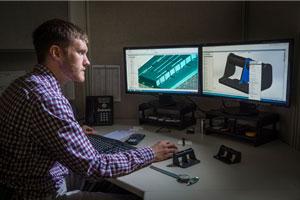Capabilities
The process of plastic injection molding is designed to produce precision parts at a low cost. The part design must be developed to maximize the efficiency inherent in high-volume molding. With the right design, parts can be made consistently and with quality. Without a good design, costly processing mistakes can be made.
Plastic Injection Molding: Part Design
Versatile, reliable, and cost-efficient, plastic injection molding is used across a range of industries to create complex, intricate part shapes.
This manufacturing process involves feeding small plastic pellets into an injection molding press and then heating them to a molten stage. After the plastic is sufficiently heated, it’s inserted into a stainless steel mold, where it stays, or “dwells,” for a very short period before cooling to ensure the material completely fills the mold cavity. A clamping unit holds the mold together during the injection and cooling process. After cooling, the part is released, and the process is repeated.
The Benefits of Plastic Injection Molding
Plastic injection molding offers a range of unique benefits. First, it allows companies to produce parts in complex shapes that would be too difficult or costly to machine otherwise. The process also allows many plastic parts to be created at the same time, making it ideal for high-volume applications.
Other key advantages include low labor costs, high repeat tolerance, and minimal required work after molding. The process also produces very little waste, since the unused plastic scrap can be easily recycled and used in other molding projects
However, it’s imperative that the initial design be precise, or costly and time-consuming processing mistakes may be made. There are several essential design elements to consider in order to ensure successful injection molding: wall thickness, rib design, boss design, corner transitions, weld lines, gate placement, and properly placed vents.
Key Aspects of Injection Molded Part Design
Wall thickness, rib design, and boss design are crucial factors in ensuring proper part design. First, maintaining a uniform wall thickness is imperative, as this will eliminate most of the defects that can occur during manufacturing. When melted, plastic will flow into areas of least resistance, which means it will fill the thick-walled areas first. Not only will a uniform wall thickness help a mold fill correctly, it will also help it cool properly. Thicker regions in the part design can be cored or hollowed out to maintain uniformity.
Next, ribs contribute to overall part strength, supporting the walls and other dimensional components. Typically, ribs make up 50% to 70% of the wall’s total thickness. If they’re wider, sinking may occur. Also, ribs cannot be too tall; generally, they should be less than three times the nominal wall thickness. The corners should include radii, and a draft angle should be included to allow the part to be ejected from the mold.
Finally, bosses help accommodate assembly through screws or pins. Bosses should be the same thickness as ribs. Also, as with ribs, bosses must have draft to aid in ejection.
Other essential design elements include corner transitions, weld lines, gate placement, and adequately placed vents. Corners should have a curve, not an angle, as sharp corners or angle changes will impede the flow of plastic. Next are weld lines, common to all plastic-injection molded parts. These lines form when two material flows converge, so it’s important to design the tool in a way that will not compromise part integrity. Gate placement, meanwhile, ensures a mold fills appropriately, while gates direct the flow of plastic from the runners for distribution around the part. To avoid flow marks, gates should be placed in a way that allows for minimized flow length. Finally, properly placed vents must also be considered. When set correctly, vents assist in reducing weld lines while allowing the gas/air in the mold cavity to escape.
Experience and Knowledge
The design engineers at Rodon have over 25 years of experience not only designing molds but building them as well. This background gives our in-house team the ability to find creative solutions to even the most challenging design manufacturing problems.
Our experienced designers are equipped with state-of-the-art software including Solid Works. They assess the part design and make modifications and recommendations based on key product requirements including product usage and function. They look for answers to questions such as:
- How will the part be used? What is its application? Is it a standalone product or a component of a larger assembly?
- What are the dimensional and tensile requirements?
- Does the part need to withstand elements, pressure, chemicals?
- Does this part meet our requirements for volume and size?
Taking all of these manufacturing factors into account is a challenging task and one that requires a strong knowledge base, not only of mold design but the injection molding process as well. It’s the first key step of our concept to completion manufacturing solution at Rodon, and we strive to get it right from the start.
Learn More
Following the key design elements detailed above will help ensure a clean, perfectly formed part. To learn more about the benefits of plastic injection molding, or to discuss options for your specific application, reach out to The Rodon Group today.
We’ve been providing high-volume, custom plastic injection molding services since 1956, and we’ll work closely with your team to create a reliable solution for your exact needs.
What’s next after concept and design?
Learn more about our Toolmaking phase.
Interested in learning more about what sets us apart from the competition?
Ready to get started? Request a Quote








![[Interactive Blog] Designing the Perfect Plastic Part](https://no-cache.hubspot.com/cta/default/91208/3671d2a3-c65e-4097-a4ea-004b1577655e.png)



